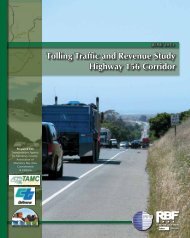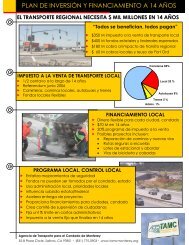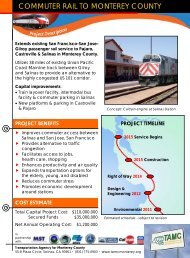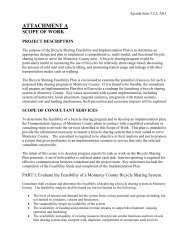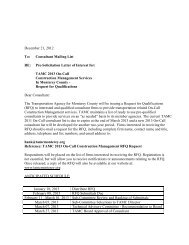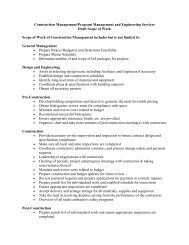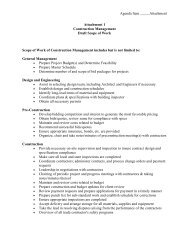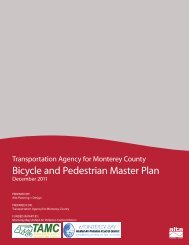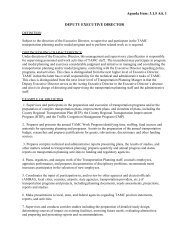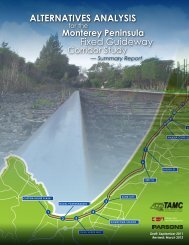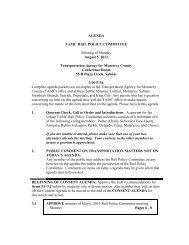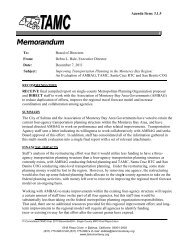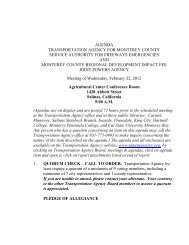Commuter Rail Extension Alternatives Analysis - Transportation ...
Commuter Rail Extension Alternatives Analysis - Transportation ...
Commuter Rail Extension Alternatives Analysis - Transportation ...
You also want an ePaper? Increase the reach of your titles
YUMPU automatically turns print PDFs into web optimized ePapers that Google loves.
CALTRAIN EXTENSION TO MONTEREY COUNTYALTERNATIVES ANALYSISThe proposed extension of Caltrain service to Salinas will recover approximately twice this rate (73.8percent). This higher recovery rate is due to three factors:1. The incremental increase in operating expense is based on the operation of trains over 37miles of UP track between Salinas and Gilroy.2. The incremental increase in fare revenue is based on riders paying fares reflecting an averagepassenger trip length of 74.2 miles.3. The ratio of average fare to operating expense is twice that of existing Caltrain service.Insofar are the Express Bus Alternative, the farebox recovery projected for 2010 operations andridership is 38.6 percent, equal to existing Caltrain service. This lower than Caltrain <strong>Extension</strong>Alternative recovery rate is due to the following:1. The incremental increase in operating expense is based on the operation of buses to servicean average passenger grip length of 74.2 miles.2. The incremental increase in fare revenue is based on riders paying fares reflecting an averagetrip length of 74.2 miles3. The Express Bus Alternative ratio of average fare to operating expense is 1.0, equal to that ofexisting Caltrain service.Population ServedThe Caltrain <strong>Extension</strong> and Express Bus <strong>Alternatives</strong> will serve commuters traveling to jobs in SiliconValley; students attending colleges and universities in the San Francisco Bay Area; business andrecreational travelers using the San Jose and San Francisco airports; and residents accessing healthcare facilities, sports venues, recreational destinations and shopping attractions in the San FranciscoBay Area.As of 2000, more than 233,000 residents of Monterey County and southern Santa Cruz County livedwithin 4.5 miles of one of the three Caltrain <strong>Extension</strong> Alternative commuter rail stations. By 2025,more than 330,000 residents of these counties will be served by these three stations. Additionalresidents in Marina and Seaside would be served by the Marina/CSUMB (California State University–Monterey Bay) Transit Center and park-and-ride facility proposed for the Express Bus Alternative.Figure 8-3 illustrates the station access buffers for the three Caltrain <strong>Extension</strong> Alternative stationslocated in Pajaro/Watsonville, Castroville and Salinas. Household population statistics for the threestations are reported in Table 8-38.Racial and Ethnic Population ServedMonterey CountyThe communities of Pajaro and Castroville are unincorporated areas of Monterey County. Accordingto the findings of the 2000 U.S. Census, approximately 47 percent of Monterey County’s population(unincorporated and incorporated areas) was identified as being of Hispanic/Latino background. Ofthe total 401,762 persons reported in the 2000 U.S. Census data for Monterey County, 187,969identified themselves as of Hispanic/Latino background and the remaining 213,793 persons wereidentified as non-Hispanic/Latino (Monterey County, 2003).parsons CHAPTER 8: EVALUATION OF ALTERNATIVES 202



